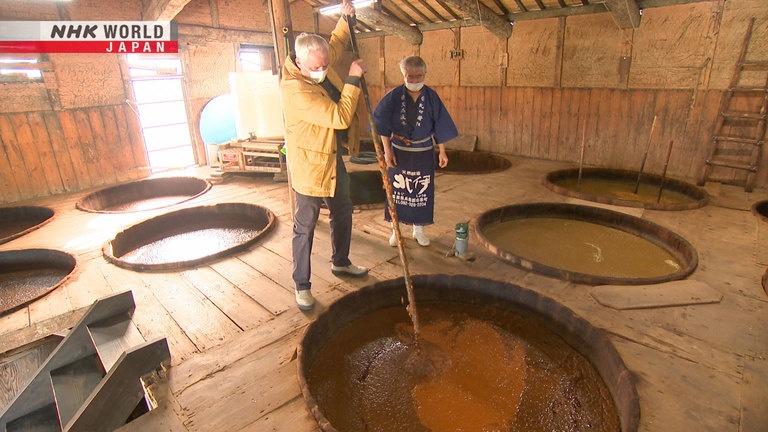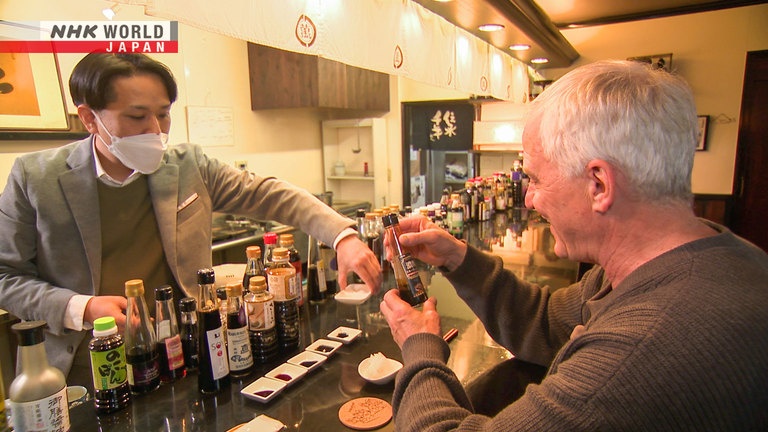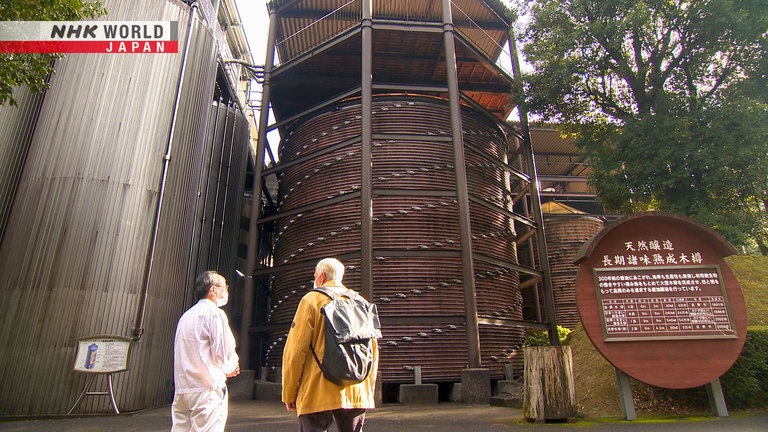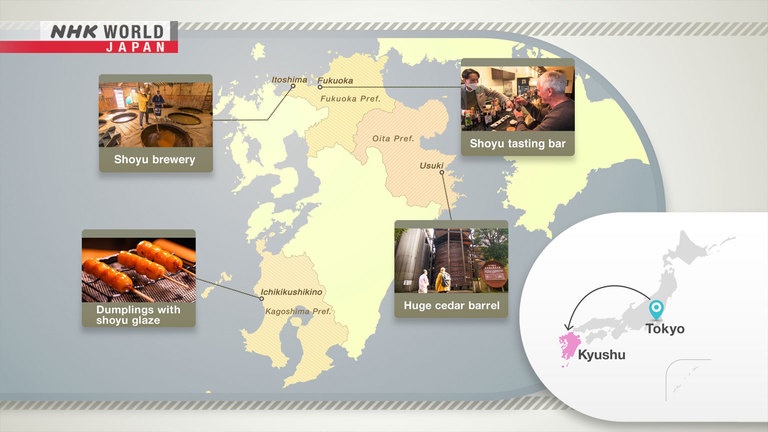Kyushu: On the Trail of Shoyu
Shoyu, or soy sauce, is a condiment at the heart of Japanese cuisine. In Kyushu it evolved into an array of flavors and aromas with locals pairing different types according to the dish. As you move south, shoyu tends to become sweeter. In this journey, we travel 350 kilometers, from north to south, to discover the depth of shoyu.
Shoyu Brewery

Located in Itoshima in Fukuoka Prefecture, this brewery has a history of about 130 years. It's one of the rare artisanal makers that produces shoyu naturally using domestic soybeans as well as wheat and long maturation in cedar barrels.
Shoyu Tasting Bar

At this shop in Tenjin, Fukuoka, you can sit at the bar and sample various shoyu types. The owner-sommelier will walk you through selections from his collection of 250 varieties.
Oita Shoyu Brewery Union

This is the largest shoyu factory in all of Kyushu. While most of their brands are brewed using cutting-edge technology, they also make premium labels in the world's largest cedar barrel, standing 9 meters tall.
Access

It takes 1.5 hours from Tokyo to Fukuoka by plane. From Fukuoka to Oita and Kagoshima Prefecture, enjoy the charming local trains.
"Journeys in Japan"
Hi everyone, how's it going?
I'm Doug, and I'm here in Fukuoka City, the gateway to Kyushu.
I'm from Canada, but I've been here close to 30 years,
and one of the great features of this city is the food.
And what gives the local cuisine a real edge is the soy sauce.
There are a countless number of soy producers in this city alone,
but please, join us on a journey as we explore the roots of soy sauce
throughout the island of Kyushu.
"Shoyu," at the heart of Japanese cuisine.
In Kyushu, the seasoning is highly evolved
with different types paired with specific dishes.
And its range of flavors tends to gravitate sweeter the further south you go.
On "Journeys in Japan," Doug, who is based in Fukuoka,
travels a 350 kilometer stretch of Kyushu
from north to south to savor shoyu's rich flavors and aromas.
At each stop, he discovers how they bring out the full taste of local delicacies.
Wow, it's all fantastic.
Kyushu: On the Trail of Shoyu
Kyushu, some 1,000 kilometers southwest of Tokyo.
Our culinary journey kicks off in Itoshima to the north.
This peaceful seaside town is home to a brewery
that continues crafting soy sauce in the time-honored way.
Oh yeah, this must be the place.
Wow, how old is this place? It looks ancient.
Already starting to get the rich aroma of the soy.
This maker has been operating for around 130 years.
Hello, I'm Doug.
Nice to meet you.
We make shoyu in cedar barrels using natural fermentation processes.
Do you know what shoyu is made from?
I use it every day, but I don't know how it's made.
Soybeans are the main ingredient.
These are Kyushu sourced.
We reconstitute them in water and steam them.
I see, wow.
The process begins by mixing steamed soy beans with toasted,
crushed wheat in which "koji" mold is added.
This is left to rest for a few days.
Oh! Look at these.
After adding brine,
the whole mixture is left to mature and ferment
in cedar barrels to make mash.
We mature the mash for about 2.5 to 3 years.
After 2 years, the flavor, color, and aroma pop out significantly.
These barrels, which have been used since the 19th century,
store bacteria that enrich and deepen flavor.
Here's a 3-year-old soy sauce.
- Would you like to taste it?
- Absolutely.
See, the surface changes color when stirred.
The surface has oxidized, turning into this color.
Taste too much and it'll be too salty.
Okay.
It's a little salty.
But there's a deep, rich taste.
You could see how using this would be great for different recipes,
not just for putting on fish, but mixing into stews.
It's made just with soybean, wheat, and salt over a span of 3 years.
What would it be like after a decade?
Sourness and the smell of bacteria would become overwhelming after 3 years.
So, I wouldn't recommend that.
After straining the liquid from the mash, the shoyu is ready for bottling.
This authentic method, with long maturation and no additives,
is on the verge of extinction.
This brewery still directly delivers to its local customers,
some 1,000 households, for free.
Doug tags along on a run.
And there's no need to wait for orders.
The brewers know just when families are about to run out.
Most people buy shoyu at supermarkets these days.
So, we mainly deliver to seniors who can't carry heavy bottles.
Hello.
Nice to see you again.
You're short one bottle, so I will replace it.
- I've replaced a bottle.
- Thank you.
Do you always use this brand?
Just this one.
Because of the flavor?
We've never used any other shoyu.
It's what we're most familiar with.
Good afternoon.
Thanks for coming.
- You always use this shoyu?
- Yes.
Because it's good.
They leave a supply around the time I'm running low, even if I'm not at home.
This may sound rude, but does it pay doing free deliveries?
Well, above all else, we believe we're contributing to our community.
We're doing our best because we want to deliver safe food to people living here.
That's a wonderful mindset.
Using only natural ingredients, wooden barrels,
time, and the human touch,
this brewery is committed to quality to serve its community.
(Fukuoka City)
Oh, here it is.
I've heard this is a really interesting shop.
Let's go inside and check it out.
Hello.
Hi, I'm Doug.
I'm Ohama. Nice to meet you.
There's such a variety here!
This boutique specializes in all things soy sauce
with an emphasis on Kyushu products.
Wow, there's so many different types. And what about the color here?
This one is our sour soy sauce.
- We call it "ponzu."
- Ponzu. Right, right.
Good for Japanese tofu and "nabe."
For yogurt and ice cream as well.
This one is a sweet soy sauce.
It's nice.
Okay, but it's still made mainly from soybean.
Yes.
I've never heard of anything like that before.
Kyushu has long produced an array of flavors.
Sweet, "umami"-rich, or citrusy
to complement regional and seasonal dishes,
apparently 1,000 styles.
- So we have a tasting room.
- Tasting room.
So please try our soy sauce.
You can drink a lot more.
Oh, it's got a nice space too, as well.
From the many bottles on the counter,
Ohama Daichi selects some customer favorites.
Fresh crisp "daikon" slices are perfect for appreciating their differences.
- This is a Fukuoka soy sauce.
- That's right. From the...
Nice smooth taste to that. Yeah.
I don't taste much salt at all.
- Let me try the next one.
- This is north side soy sauce.
No adding. A straighter natural soy sauce.
North side soy sauce uses a different koji.
I don't know how to describe it but there's definitely a different taste.
I thought that was mild, but this one's even got a little milder edge to it.
So we call it "sashimi soy sauce."
We have Fukuoka adding umami and sweetness.
- A little sweeter.
- Yes.
Not so much that it's outstanding but,
that'll be really nice on fish, I'm sure.
- So, you like barbecue?
- Yes.
I have the smoked soy sauce.
Maybe you'll like it.
Okay, we'll see. That's the one you recommend for the barbecue.
Here we go, smoky.
Definitely got that smoky edge to it.
You can taste the smoke in that. It's unbelievable.
It's been sitting next to a campfire or something. That is really good.
That, I'd like to try with a barbecue.
Well, this has not only been very educational but pretty
mind opening as far as the variety of taste you can experience
with a soybean-based soy sauce.
I mean, this is completely beyond what I expected to try today.
And I'll be back.
Usuki City in Oita.
Known for its pristine spring water,
Usuki flourished as a shoyu producer
thanks to ample soybean and wheat harvests.
It is even nicknamed "the city of soy sauce."
Kyushu's oldest brewery, 400 years to be exact,
is located here, as well as two major producers.
Excuse me.
Hello.
What a fascinating place. When were you established?
We began business in 1883. 2023 is our 140th anniversary.
There's a huge variety. May I taste a representative shoyu?
Of course.
Thank you.
Yeah, a little bit sweeter than the ones we tried in Fukuoka.
And it does have that rich, savory depth to it.
Why is shoyu in Oita sweeter than the Fukuoka style?
Fukuoka people up north prefer shoyu with more umami.
People in the south prefer sweeter ones.
Oita is in between. So, shoyu here has both sweetness and umami.
Welcome.
I've come to enjoy your great local seafood.
Please have a seat.
This is a selection of local sashimi.
Fish caught in Oita mature in the swift currents,
making their meat firm and fatty.
This is a local shoyu.
It's sweeter compared to those from the Kanto region.
Let me try it.
Yeah, it goes so well together.
You don't get any really fishy aftertaste at all when you use this
local soy sauce.
I like the way the sweetness of this goes really well with the local fish.
With a spritz of "kabosu," a citrus fruit that's an Oita specialty,
you can enjoy a different taste.
Adding citrus to shoyu brings out a refreshing taste in the fish.
It also adds a new edge to it, a new kind of savory edge that
you don't get when you don't use it. And I got to say,
that really adds to the flavor
that goes deeper into the fish.
This is one of Usuki's major breweries.
Hello. I'd like to take your tour.
We've been expecting you.
It's vast.
This shoyu factory is the largest in Kyushu.
We produce about 20,000 kiloliters a year.
The stainless-steel tanks are 10 meters in height.
Massive amounts of unrefined shoyu
can be matured efficiently in these tanks.
They allow you to ferment and mature shoyu all year round at desired temperatures.
By controlling the temperature, you can make a batch in about 6 months.
Wooden barrels take more than a year.
- So, this is more economical.
- Yes, more efficient.
But some of the shoyu here is produced the old way
in a wooden barrel.
And not any old cedar barrel.
Measuring 9 meters in both height and diameter,
it is the world's largest.
About 30 years ago, an argument started
that shoyu produced in the old wooden barrels was tastier.
So, we began experimenting with steel and wooden tanks
using the same ingredients at the same time, to find out.
Wooden tanks came out the winner.
Why do you think that is?
We're researching this, but still don't have all the answers.
Shoyu mash gets better with the help of microbes, yeast, and lactic acid bacteria.
The environment in wooden barrels promotes the work of these microorganisms.
That's fascinating.
The slower temperature changes in larger vessels
are believed to be behind the deeper flavors.
These tanks all contain moromi, unrefined soy sauce.
We're now on top of the world's largest wooden barrel.
I'd like you to see the moromi.
The mixture is stirred to send oxygen into the yeast and reduce gas.
The scale that they're doing the work here is amazing, this process.
Since they started stirring it, this pungent aroma is coming out.
This moromi is fermented and matured for 3 years.
We'll be able to filter it in March 2024.
We believe 3 years is important for maturing.
One was fermented in our wooden barrel.
The other in a stainless tank.
The left one is from the wooden barrel.
Yeah, I got to say there's a little bit of a sweeter edge than what I've tried up till now.
And a little more refined as well.
How about this one. I won't take too much. I'll try the stainless.
Slightly... slightly saltier taste.
Yeah, I got to say I like the one from
the wood because it's got a little sweeter edge that I prefer.
They're both great, but if I had to choose one, I'd go with the
yellow cedar.
Well, here we are in the southern tip of the island of Kyushu in Kagoshima.
In the background is Sakurajima, an active volcano.
It's not unusual for it to erupt and spew ash all over the city.
They say that Kagoshima's soy sauce has its own unique taste and quality.
Let's go check it out.
Hello.
I'd like to go on your factory tour.
I'm Doug.
We've been expecting you.
Please come inside.
This popular brewery, founded around 100 years ago,
produces shoyu typical of Kagoshima.
This is where we mix the ingredients.
Now we're going to add sugar for sweetness.
- You add sugar?!
- Yes.
- Is it from sugarcane?
- That's right.
It isn't refined sugar, but a rawer kind.
The sweetener gives shoyu complexity.
Wow, that's a lot of sugar.
They do like their stuff sweet down this way.
The end product is of course sweet,
but the locals add even more sugar to make it sweeter.
- I'd like to try some.
- Sure.
Here you go.
Yeah, it's got a real full-body taste. Like, you could taste a bit of salt.
The sugar is not... The sugary taste is not overpowering.
It's a real nice balance.
- It's really good.
- Thank you.
Why is Kagoshima's shoyu sweet?
Sugar has long been produced south of Kagoshima, so it was easy to obtain.
There's also the shochu culture of Kagoshima.
Shochu is dry, so it complements sweetness.
Shochu is a distilled spirit, and in Kagoshima,
its base ingredient is the local sweet potato.
Its flavor is bold, earthy and dry.
Here's the moment I've been waiting for. Local shochu.
And the local soy sauce together with the local fish.
Tuna caught in Kagoshima is fattier than Oita's,
so it's paired with a sweeter, more viscous shoyu.
I really appreciate how that works together. The dry local shochu taste
with a slightly sweeter soya.
The winning combination.
The brewery that Doug just visited runs a shop here.
Hi.
Wow, what an attractive shop we have here.
All kinds of different soy sauce. Other sauces as well.
Oh, it's kind of like a cafe over this way.
I'm going to have to try their specialty, see what they've got.
- Excuse me.
- Hello.
What's your specialty?
It's our shinko dango.
Dumplings in soy sauce glaze...
I'd like to have three, please.
Thank you.
The glaze is made from the sweet shoyu of Kagoshima
enhanced with extra sugar.
It gives off a really nice
savory aroma that
I haven't experienced up until now.
All right. Here we go, a big taste test.
Again, I don't want to burn my tongue.
You just can taste that sweet soy sauce
coming out directly to your taste buds.
And it's followed by this nice aroma you get with it.
This is one nice treat.
The brewery also promotes their products,
and by extension Kagoshima specialties, from their food truck.
So, you want many people to savor these delicious dumplings.
We'd like people to realize the appeal of sweet shoyu
through dumplings, and use it more.
Well, here we are at the end of our great soy sauce journey through Kyushu.
It's been an eye-opening experience for me to say the least.
Not only have I learned about the processes involved in the production of the sauces,
such as the sourcing of the materials and the combination of
literally ancient equipment with cutting edge technology,
but I've also developed a deep respect
for the hard work and commitment the producers have put in
for generations
to create the ideal sauces and blends
to suit and match the local specialties and delicacies.
This journey leaves me with a better appreciation of
how important a role do umami
or savory taste of soy sauce plays
in the creation of delicious Japanese cuisine.
It's 90 minutes by plane from Tokyo to Fukuoka.
To carry on to Oita or Kagoshima,
board some of the lovely local trains.